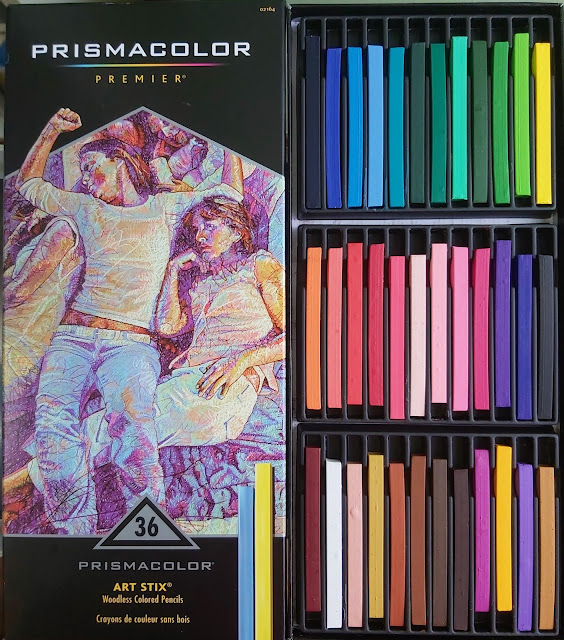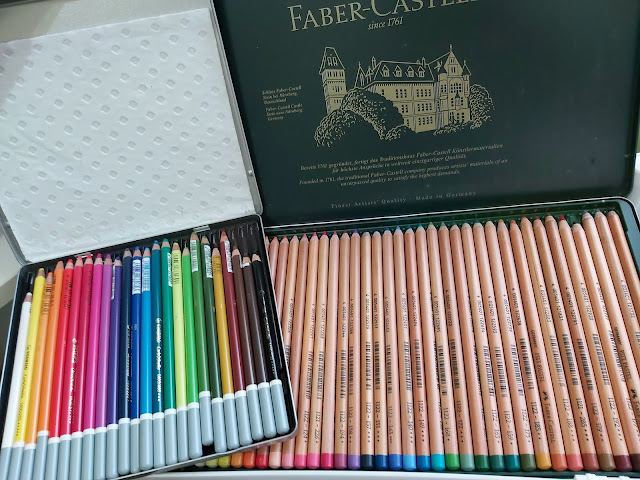Review: Prismacolor Art Stix - if a crayon and a coloured pencil had a baby
When I first ventured into coloured pencils and did some research online, the brand Prismacolor kept popping up. In the past, people raved about the soft core pencils, saying they're the softest and creamiest coloured pencils they've ever used. However, in recent years, Prismacolor has fallen out of favour as it has been reported that new manufacturing processes have resulted in a reduction in quality. The common complaint is constant breaking of the lead when sharpening.
For this reason, I eschewed Prismacolor coloured pencils in favour of Derwent, Caran D'Ache and Faber-Castell. But I remained curious about the soft core lead that everyone was talking about. Then recently, I came across Prismacolor Art Stix on sale on Amazon Singapore. Art Stix? I'd never heard of it. What's that?
After some online research, I discovered that Art Stix are basically woodless coloured pencils. That means they have the soft core of the regular Prismacolor coloured pencils without the wood casing. They're sticks of lead that look exactly like pastel sticks (except they're not).
I immediately thought: "oh, so you'll get the Prismacolor soft core coloured pencils without the problematic casing that causes the lead to break!" It sounded terrific except for one niggling issue: why the heck would I need woodless coloured pencils? They're supposed to be good for backgrounds since you can use the sticks on their side and cover large areas that are usually the most laborious when using regular coloured pencils with their teeny exposed leads. That sounds terribly niche to me, especially when I don't remember the last time I used coloured pencils for backgrounds. There also aren't a lot of reviews on the Internet - the Art Stix aren't a wildly popular product.
But my heart goes a little mad when it comes to art supplies, especially art supplies at a discount. "We don't need them!" my brain scolded my heart. "But they're so preeeeetty," my heart whined. The 36-stick set was on sale at S$20 (about US$14, which is less than half the recommended retail price). I watched the price gradually decline over a week or so. It went from S$20 to S$18.70, then when it finally dropped to S$16.24, I caved and ordered it. My heart won.
The first thing I noticed when I opened the box was that the Art Stix have a noticeably chemical smell. The second observation was that they look exactly like Nupastels. Nupastels are the semi-hard pastel sticks also by Prismacolour (review here).
So I took out some equivalent colours from my Nupastel set to have a closer comparison and here they are. Nupastels are on the left of each colour and Art Stix on the right. Apart from the length, they look very similar. Maybe the factory uses the same molds to save money.
The performance, however, is very different, as I would expect. Nupastels, being soft pastels, go on much more vibrant and the pigment comes off easily at the slightest touch. They also create pastel dust. All the dust you see on the paper is from the Nupastels. It's a lot of dust just for scribbling some swatches. For the Art Stix, I needed to press them down more heavily and the colours are not as vivid. However, I have to say that I was surprised by how creamy the Art Stix felt. As far as coloured pencils go, these are very soft. Nupastels also smudge, whereas the Art Stix swatches stay put.
Now to put the Art Stix to the test. I didn't want to draw anything too time-consuming, so I decided on a half-comic drawing that wouldn't require too many finicky details. My daughter suggested a startled turkey, which made me laugh. I can't imagine this is the best time to be a turkey.
Quick sketch and blocking in of colours. Right away, I discovered that the Art Stix are perfect for coloured pencil underpaintings, which typically take forever.
Revelation: I can draw lines with them like regular coloured pencils! In fact, the versatility of the sticks surprised me. I can colour large areas with the long edge, make marks with the short edge, twist it around and draw thin lines with a corner - without having to switch tools once. I especially love using the short edge, it's like painting with a pastel stick. No mess, no sharpening needed. It felt utterly liberating drawing this turkey.
Then came the background which was what the Art Stix are supposed to excel at. I used the long edge to fill in the blanks. That took no time at all, and I could use the shorter edge to go around the nooks and crannies. Very handy.
Then I used Zest-it Pencil Blend to blend out the background and that's when I remembered why I don't like coloured pencils for backgrounds. It's hard to get that smooth look that's so easy with pastels. It's patchy, the grain shows through some parts, and you need several layers for things to kinda smoothen themselves out. In the end, I decided that the streaky look would have to do. Maybe I'll start a trend for lazy coloured pencil artists.
 |
| "I'm invited for dinner??" |
My verdict
I love the Art Stix much more than I expected to, mainly because I didn't think they would be so versatile. It can lay down pigment quickly like a crayon, yet have the ability to draw details like a coloured pencil. It really is the best of both worlds. For people like me who don't like spending a lot of time on one painting, they're terrific. It took me one hour to draw the turkey, and another 45 minutes for the background.
The formula of the Prismacolor Soft Core coloured pencils is fabulous. Creamy and vibrant. They're so soft that they create some crumbs on the paper, and they do dirty your fingers slightly, but nothing like the mess a pastel stick would make. I'm so glad I got them in this form instead of in the regular pencils. They layer quite well too. I could easily get 3 or 4 layers on the Canson Mi-Teintes paper (and I did press quite hard), although having gotten used to pastels for a while now, I forgot I had to draw the lights in before the darks. But nothing a little erasing can't fix.
So two thumbs up for the Prismacolor Art Stix and I'm happy to have them in my arsenal of art supplies, especially since I just discovered that they have been discontinued. Maybe that's why they were going for such a low price. If you wish to get them, I guess you should do it soon before they're unavailable forever.












You can use a piece of thin foam behind your paper to make the art stix look sooth rather than grainy. If the paper is thin, then you would need a few more sheets of paper in between the foam.
ReplyDelete